Guitar tablature, affectionately known as “guitar tabs,” is a revolutionary method of music notation that has opened the world of guitar playing to countless beginners. Imagine being able to learn your favorite songs quickly and easily, without years of traditional music theory. That’s the power of guitar tabs. While they share some common ground with standard music notation by indicating notes, rhythm, and techniques, guitar tabs offer a distinct and invaluable advantage, especially for guitarists: they show you exactly where to play the notes on the fretboard.
This is a game-changer because the guitar is unique in that the same note can be played in multiple positions across the fretboard. Understanding and mastering How To Read A Guitar Tab is therefore incredibly beneficial, allowing aspiring musicians to start playing real music almost immediately, even without prior knowledge of traditional musical notation.
At guitarplayers.net, we champion guitar tablature as a fundamental tool for learning. It’s incredibly versatile, displaying both chords and single notes clearly, making it the most direct path to learning the songs you love. Learning to decipher guitar tabs is also remarkably straightforward; all you need is a basic understanding of your guitar’s strings and frets. No prior musical knowledge is required!
If you’re eager to discover what guitar tabs are, how they work, and how they can unlock your guitar playing journey, you’ve come to the right place. Let’s dive in and explore the world of guitar tablature.
WHAT EXACTLY ARE GUITAR TABS?
Guitar tablature is essentially a visual map of music for guitarists. Think of it as a simplified language specifically designed for the instrument. A standard guitar tab is composed of six horizontal lines, each representing one of the six strings on a guitar. When you learn how to read guitar tabs, it’s crucial to understand this layout: you read the tab from top to bottom, with the topmost line representing the high E string (the thinnest string) and the lines descending to represent the B, G, D, A, and low E strings (the thickest string).
This arrangement mirrors how you see the strings when you look down at your guitar in playing position. Therefore, envision guitar tablature as your personal roadmap to musical fluency on the guitar, providing the most efficient route to learning and playing your favorite songs.
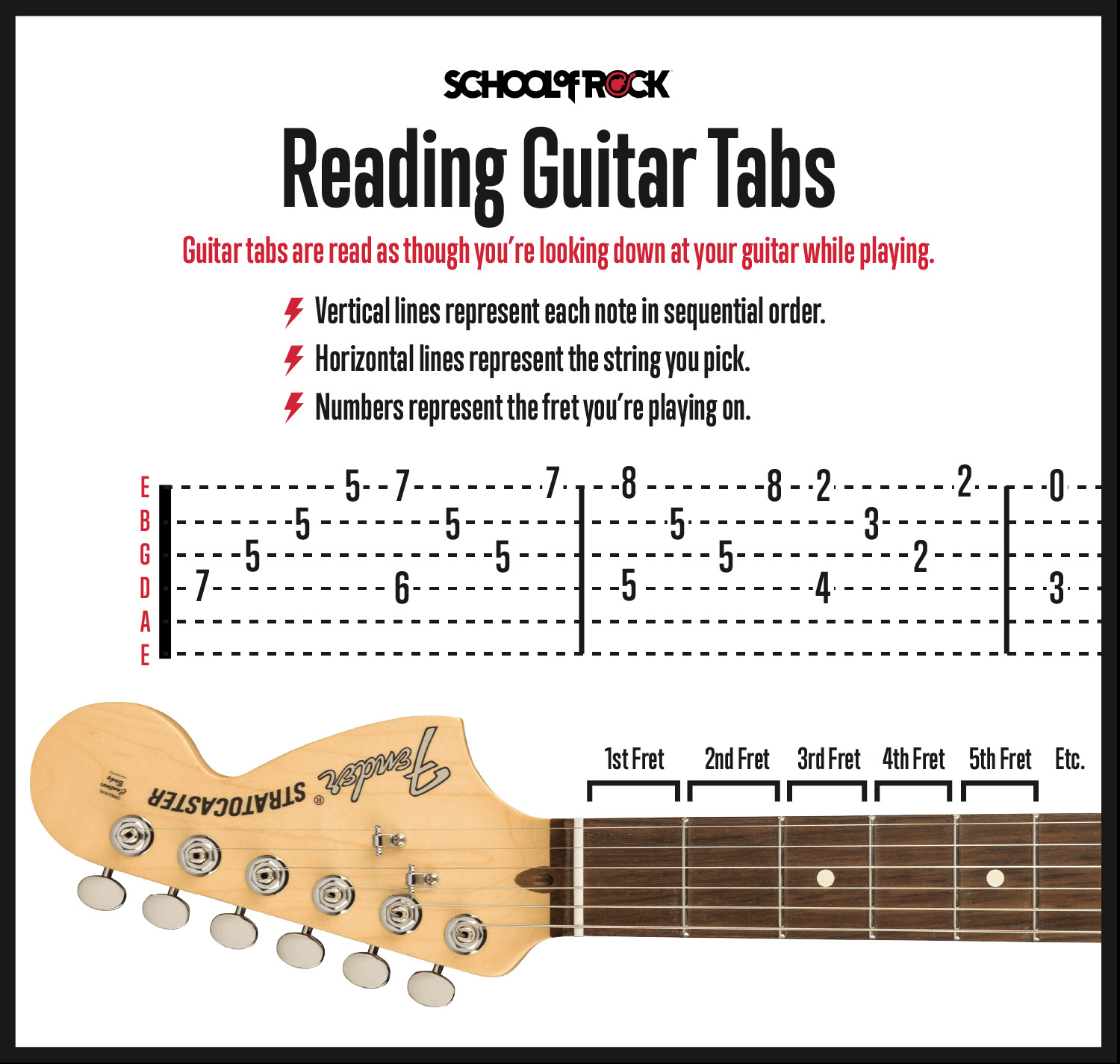 Reading guitar tabs
Reading guitar tabs
Within these six lines, you’ll encounter numbers. These numbers are the key to unlocking the fretboard, as they indicate the fret you need to press down on to play a specific note. Frets are the metal strips that run perpendicularly across the guitar neck. They are numbered from 0 to upwards of 24 on some guitars, starting from the nut (the white piece closest to the headstock) and extending down the neck.
A “0” on a string line signifies an open string, meaning you play that string without pressing down on any fret with your fretting hand. A “1” indicates that you should press down on the first fret, “2” the second fret, and so on. A fundamental aspect of learning how to read guitar tabs is internalizing this number-to-fret correspondence. Remember, each number directly corresponds to a fret position.
Understanding this basic framework is the first step to navigating the world of guitar tabs and quickly learning to play your favorite tunes.
DECODING GUITAR TABS: A STEP-BY-STEP GUIDE
Reading guitar tablature is a straightforward process once you grasp the fundamentals. Guitar tabs are read from left to right, just like standard written language. The notes you see are presented in the order they are played in the song, chronologically unfolding the music before your eyes.
When you encounter numbers stacked vertically on the tab staff, this signifies a chord. A chord is simply a group of notes played simultaneously. In guitar tabs, these vertical stacks tell you which strings to strum together to produce the desired chord. This is a significant advantage for beginners, as guitar tab notation explicitly shows you the notes that comprise a chord and, crucially, where to find them on your guitar. This directness sets it apart from standard notation, making it much more accessible for visual learners and those new to music theory.
ESSENTIAL KNOWLEDGE FOR READING GUITAR TABS
To successfully decipher guitar tabs, beginners should prioritize familiarizing themselves with two key elements of the guitar: the six strings and the fret positions. Knowing the names and order of the strings (E, B, G, D, A, E from thinnest to thickest) and understanding the numbering of the frets is foundational. This knowledge acts as your mental map, allowing you to translate the numbers on the tab into physical positions on your guitar, effectively using the tab as your guide to playing music.
UNDERSTANDING THE TAB STAFF: STRINGS, NOT NOTES
The guitar tab staff visually resembles the staff used in traditional music notation, which can initially be a bit confusing. However, a crucial distinction sets them apart. In standard notation, the lines of the staff represent musical pitches. In guitar tabs, the lines represent the six strings of the guitar.
As mentioned earlier, the top line is the high E string, and the bottom line is the low E string. This direct representation of the guitar strings is what makes reading guitar tabs so intuitive for beginners. To further avoid confusion with standard notation, guitar tabs are typically clearly labeled “TAB” at the beginning of the staff. This visual cue immediately signals that you are working with tablature and not traditional sheet music.
NAVIGATING THE FRETBOARD: UNDERSTANDING GUITAR FRETS
Guitar frets, the metal strips running across the fretboard, are the building blocks of pitch on the guitar. They divide the fretboard into semitones, each fret representing a distinct note.
Most guitars feature between 19 and 24 frets. The distance between each consecutive fret represents one semitone, also known as a half step. Within each octave, there are 12 semitones (or frets). To help guitarists navigate the fretboard visually, most guitars have fret markers, often dots or inlays, positioned at specific frets like the 3rd, 5th, 7th, 9th, and 12th frets. These markers serve as visual landmarks, making it easier to quickly locate fret positions while playing.
When reading guitar tabs, remember the number system: numbers indicate fretted notes, and “0” signifies an open string. Playing an open string simply involves picking or strumming the string without pressing down on any fret. The number “0” on the tab is your instruction to let that string ring freely.
CHORDS IN TABLATURE: VERTICAL ALIGNMENT
Guitar chords, while lacking special symbols in guitar tabs, are easily identifiable by their vertical arrangement. When you see multiple numbers stacked directly above each other on the tab staff, it indicates a chord. These vertically aligned numbers represent notes that are played simultaneously, forming a harmonic unit. You play a chord by strumming across all the strings indicated by the numbers in that vertical stack at the same time.
Even if a chord is arpeggiated, meaning the notes of the chord are played individually rather than strummed together, it will still be represented in the tab as single notes played in sequence, even though you are still fretting the chord shape.
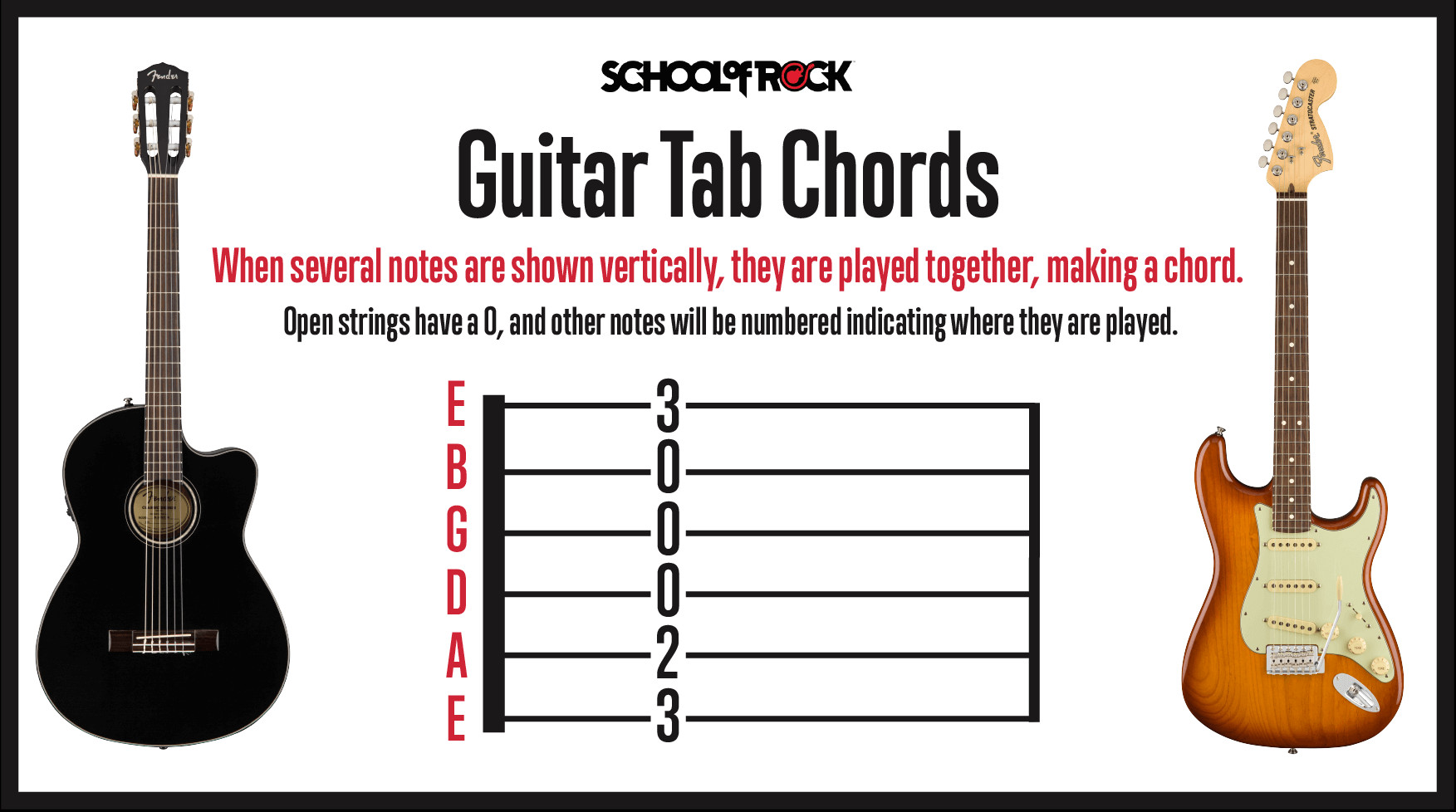 How to read guitar tab chords
How to read guitar tab chords
RIFFS IN TABLATURE: MELODY AND HARMONY COMBINED
Many rock songs, and songs in other genres, are built upon “riffs.” Riffs are essentially short, repeating musical phrases that form the backbone of a song. They often combine single notes with partial chords, such as power chords, to create catchy and memorable musical ideas.
When reading guitar tabs for riffs, the same fundamental principles apply. If you see two or more notes aligned vertically within a riff, you play them together. This consistent rule throughout guitar tablature makes learning to read tabs for riffs just as intuitive as learning chords. The visual layout of the tab directly translates to the physical actions on the guitar.
GUITAR TABS VS. CHORD CHARTS: DIFFERENT TOOLS FOR DIFFERENT JOBS
Guitar tabs and chord charts are both valuable resources for guitarists, but they serve different purposes and present information in distinct ways. A chord chart is a visual diagram that shows you where to place your fingers on the fretboard to form a specific chord. Chord charts often include finger numbers, indicating which finger to use for each string. Chord charts are frequently placed above song lyrics to indicate chord changes within the song’s structure.
Chord charts primarily focus on the essential 3 to 4 notes that constitute a specific chord. However, a complete and nuanced guitar part might include single notes, notes outside the basic chord, or arpeggios (playing the individual notes of a chord in a sequence), which chord charts don’t typically represent. For this reason, chord charts are often used in conjunction with guitar tabs, especially for beginners. Chord charts can provide a quick reference for basic chord shapes, while guitar tabs offer a more comprehensive and detailed representation of the entire guitar part.
FINGERS AND NUMBERS: CLARIFYING THE NOTATION
Guitar tablature is a linear representation of music, unfolding note by note in time. Chord charts, on the other hand, are like snapshots of your fretboard, showing finger positions for chords. Chord charts often use a numbering system to indicate which finger of your fretting hand to use for each string. The index finger is usually designated as 1, the middle finger as 2, the ring finger as 3, and the pinky finger as 4.
It’s important to distinguish this finger numbering from the numbers used in guitar tabs. In tabs, numbers indicate which fret to play, not which finger to use. While tabs don’t dictate fingerings, chord charts sometimes included in tabs, especially in beginner-friendly tabs, may offer fingering suggestions to guide hand positioning.
EXPERIENCE THE THRILL OF LIVE PERFORMANCE
[Placeholder for internal link to guitar lessons or programs]
Learn to play guitar and perform live on stage! Our experienced instructors provide a supportive environment for all skill levels.
UNRAVELING GUITAR TAB SYMBOLS: BEYOND THE BASICS
Beyond the lines and numbers, guitar tabs often incorporate symbols that represent various guitar techniques. Understanding these symbols is crucial for capturing the nuances and stylistic elements of a song. Learning how to read guitar tab symbols and apply the corresponding techniques will significantly enhance your playing and bring you closer to the authentic sound of the music.
Before delving into techniques, always ensure your guitar is properly tuned. Accurate tuning is fundamental to making your guitar sound right. [Placeholder for internal link to guitar tuning guide].
MUTING GUITAR NOTES: CONTROLLING SUSTAIN AND TONE
Muting is a fundamental technique in many genres, particularly rock music. Styles like heavy metal, punk, and alternative rock heavily rely on muting to create specific rhythmic textures and sonic character.
MASTERING MUTING TECHNIQUES
Muting can be achieved with either your picking hand or your fretting hand, or a combination of both. While primarily executed with the picking hand, muting adds dynamic control to your playing, preventing unwanted string noise and feedback, especially at higher volumes. In songs, you might find muted verses contrasting with unmuted choruses or hooks, creating dynamic shifts.
Experienced guitarists often employ muting techniques instinctively, without consciously thinking about it. Muting becomes an integral part of their playing, contributing to a cleaner, more controlled, and professional sound.
PALM MUTING: THE RHYTHMIC POWERHOUSE
Palm muting is one of the most ubiquitous techniques in rock guitar. It involves resting the palm of your picking hand lightly on the strings near the bridge while picking. The pressure from your palm dampens the strings, altering their vibration and producing a characteristic muted tone. Heavy palm muting creates a tight, percussive, rhythmic sound, while lighter palm muting allows the notes to sustain slightly longer with a warmer, muffled quality. In guitar tabs, palm muting is typically indicated by “P.M.” written above the section of tab where it should be applied.
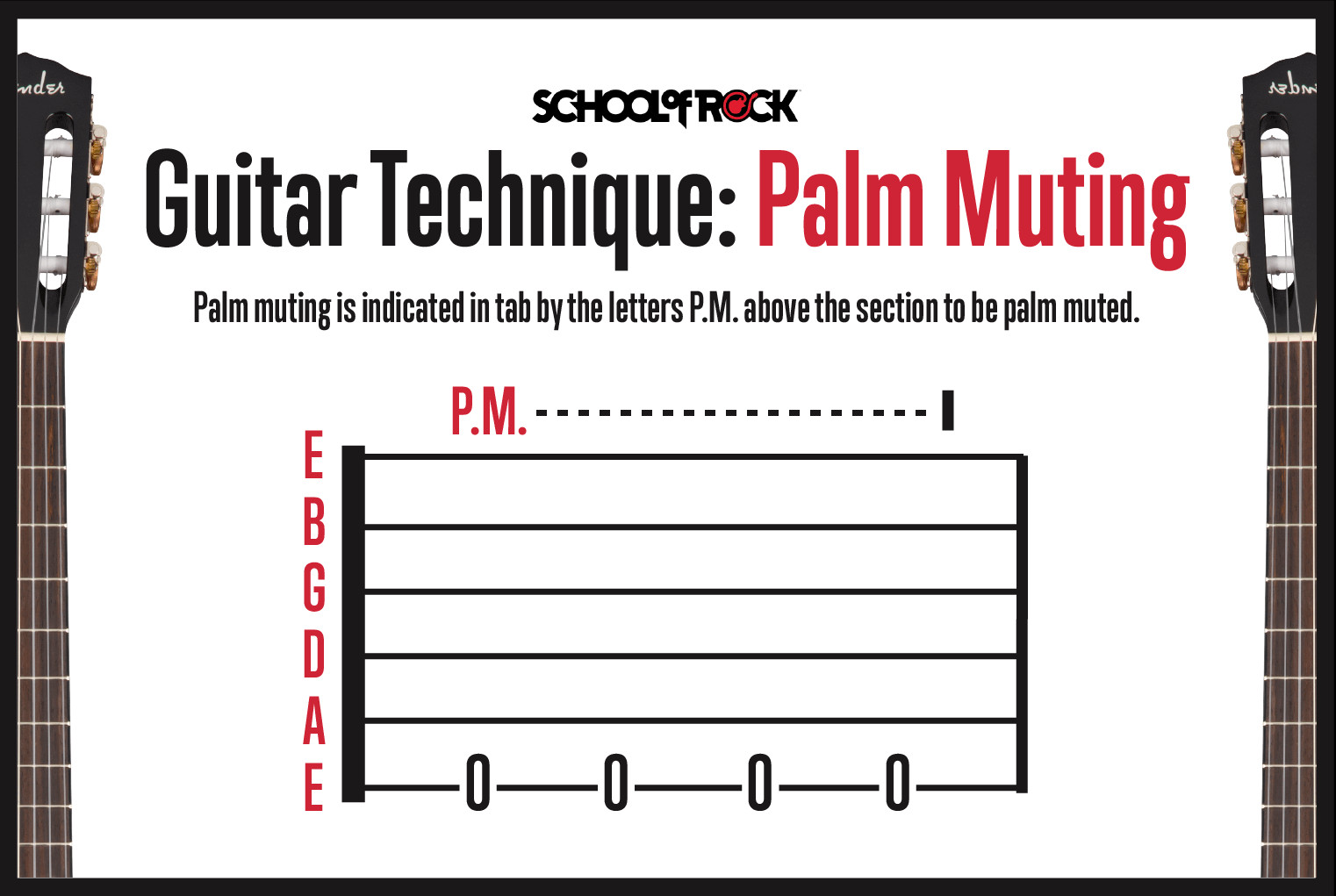 Guitar technique palm muting
Guitar technique palm muting
MUTED NOTES: THE “X” MARKER
Muted notes are a distinct technique from palm muting and are achieved using the fretting hand. In this technique, the strings are picked, but the fretting hand lightly touches the strings without fully pressing them down to the fretboard. This dampens the string vibrations, producing a percussive, almost clicking sound. In guitar tabs, muted notes are represented by an “X” in place of a fret number on the string line. This “X” signals that you should pick the string but mute it with your fretting hand.
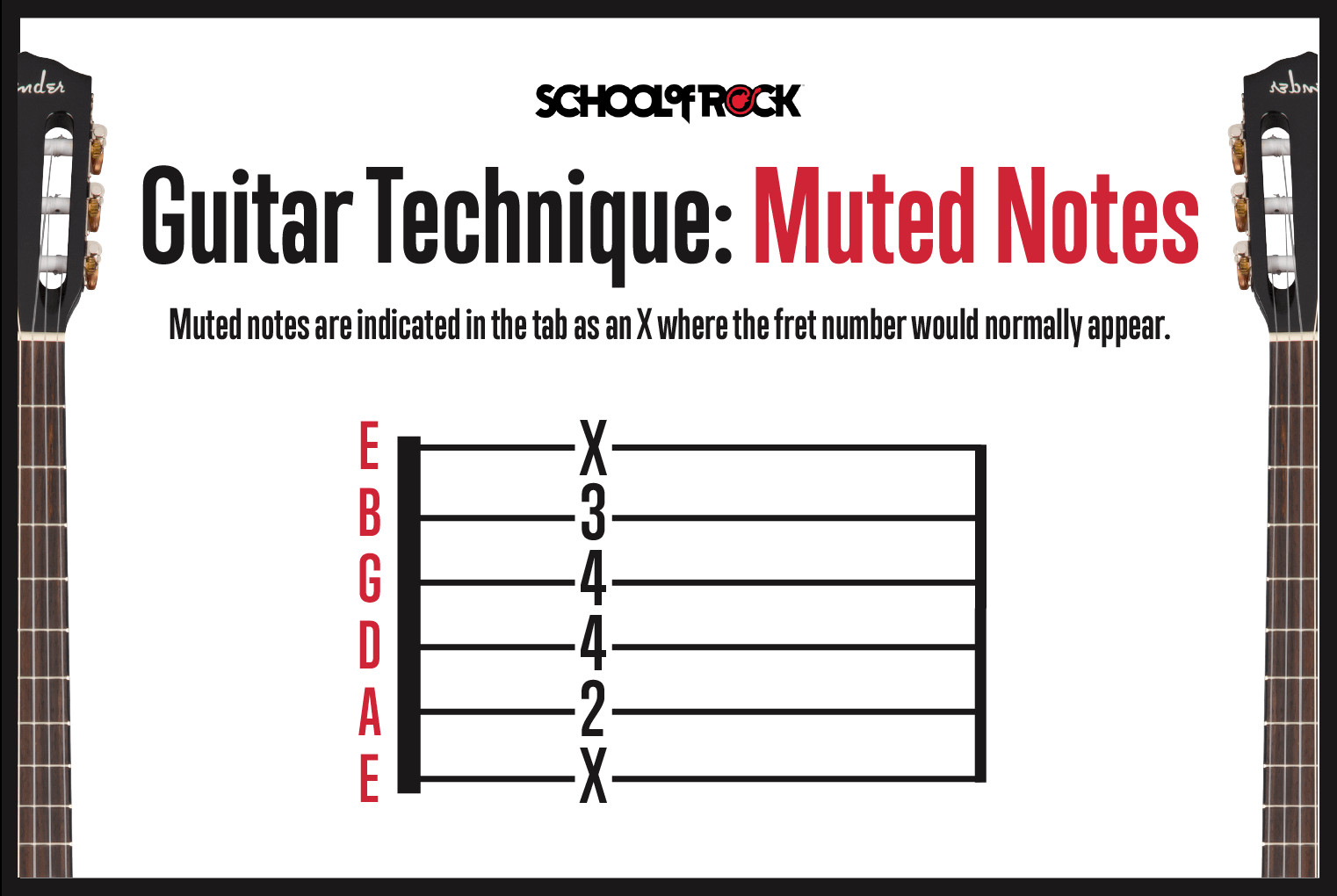 Guitar technique muted notes
Guitar technique muted notes
BENDING GUITAR STRINGS: EXPRESSIVE PITCH MANIPULATION
String bending is a core guitar technique for adding expressive, vocal-like qualities to your playing. Bends allow you to manipulate the pitch of a note, creating soaring melodies and bluesy inflections. In guitar tabs, bends are indicated by a curved arrow above the note to be bent. The arrow often includes markings like “½” or “full” to specify the bend interval – a half step (one fret) or a full step (two frets) increase in pitch. These target pitches are often referred to as “target notes.”
EXECUTING STRING BENDS EFFECTIVELY
String bending is achieved by pushing or pulling the string sideways along the fretboard, rather than pressing straight down. For most strings (except the low E), you typically push the strings upward towards the ceiling. The low E string is usually bent downward towards the floor. The key to a smooth and controlled bend is applying even, consistent pressure to the string throughout the bend.
BENDING TECHNIQUE: FINGER SUPPORT IS KEY
Most bends are executed using a combination of fingers for strength and control. The “main” fretting finger (often the ring finger) performs the bend, while the middle and index fingers provide support and stability. This multi-finger approach makes bending smoother, easier, and allows for greater control over the pitch and vibrato of the bent note.
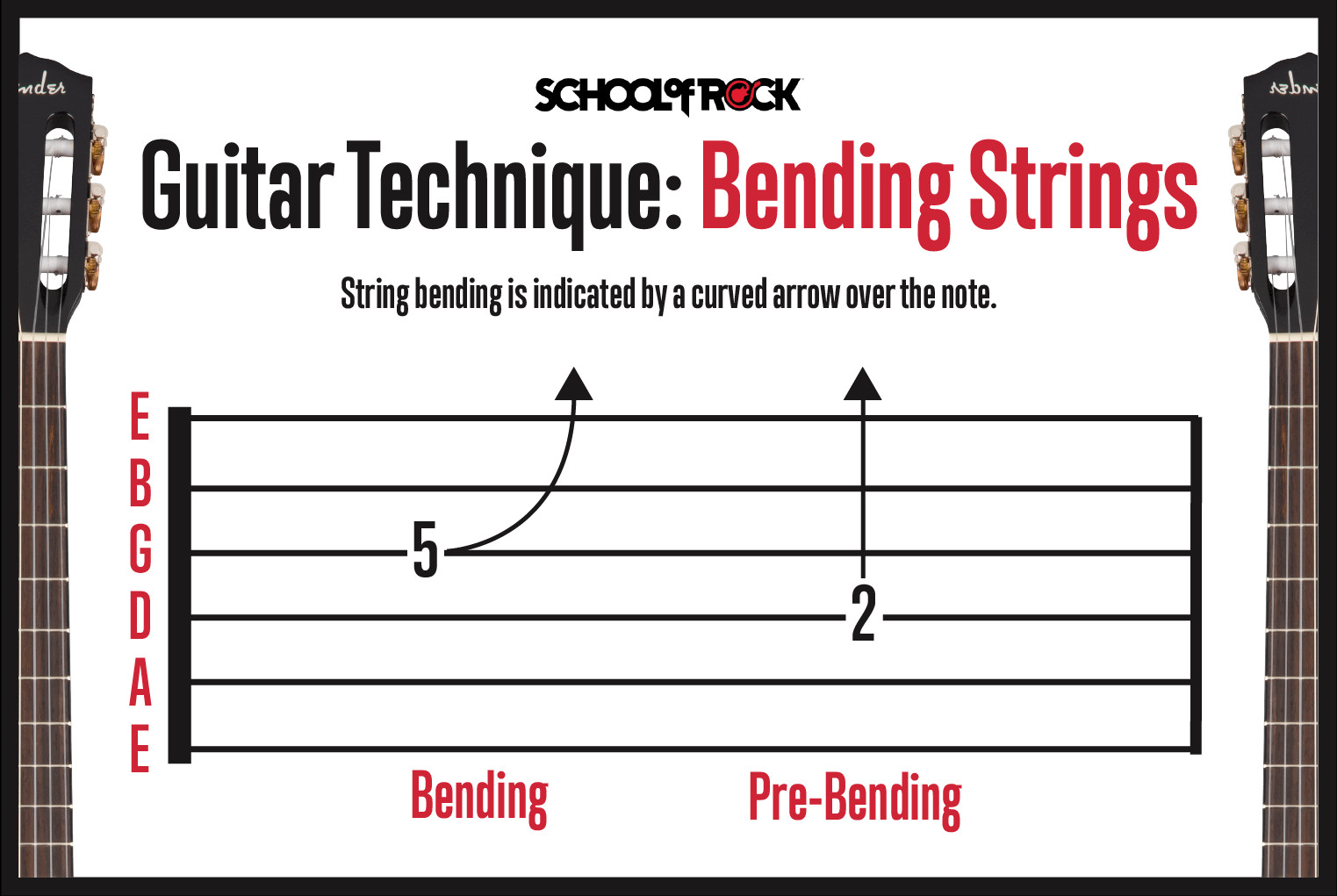 Guitar technique bending strings
Guitar technique bending strings
PRE-BENDING: ANTICIPATION AND RELEASE
Beginners learning how to read tabs on a guitar might also encounter “pre-bends.” A pre-bend involves bending the string before picking the note. The tab notation for a pre-bend shows a straight upward arrow indicating the bend amount (full, ½, etc.) followed by a curved arrow pointing downwards. After pre-bending, you pick the string and then typically release the bend, allowing the note to return to its original pitch. Pre-bends can also be bent further upwards to another target note after the initial release, creating a more complex and dynamic phrasing.
SLIDING GUITAR NOTES: SMOOTH TRANSITIONS
Sliding is another essential guitar technique for creating smooth transitions between notes. You can slide up to a higher note or down to a lower note. Sliding differs from bending; instead of altering the pitch of a single note, you smoothly move your fretting finger along the fretboard from one fret to another while sustaining the note.
SLIDE UP: ASCENDING SMOOTHLY
In guitar tabs, a slide up is represented by a line connecting the note you are sliding from to the note you are sliding to. If the target note is higher in pitch, the line will often slant slightly upwards in the tab notation.
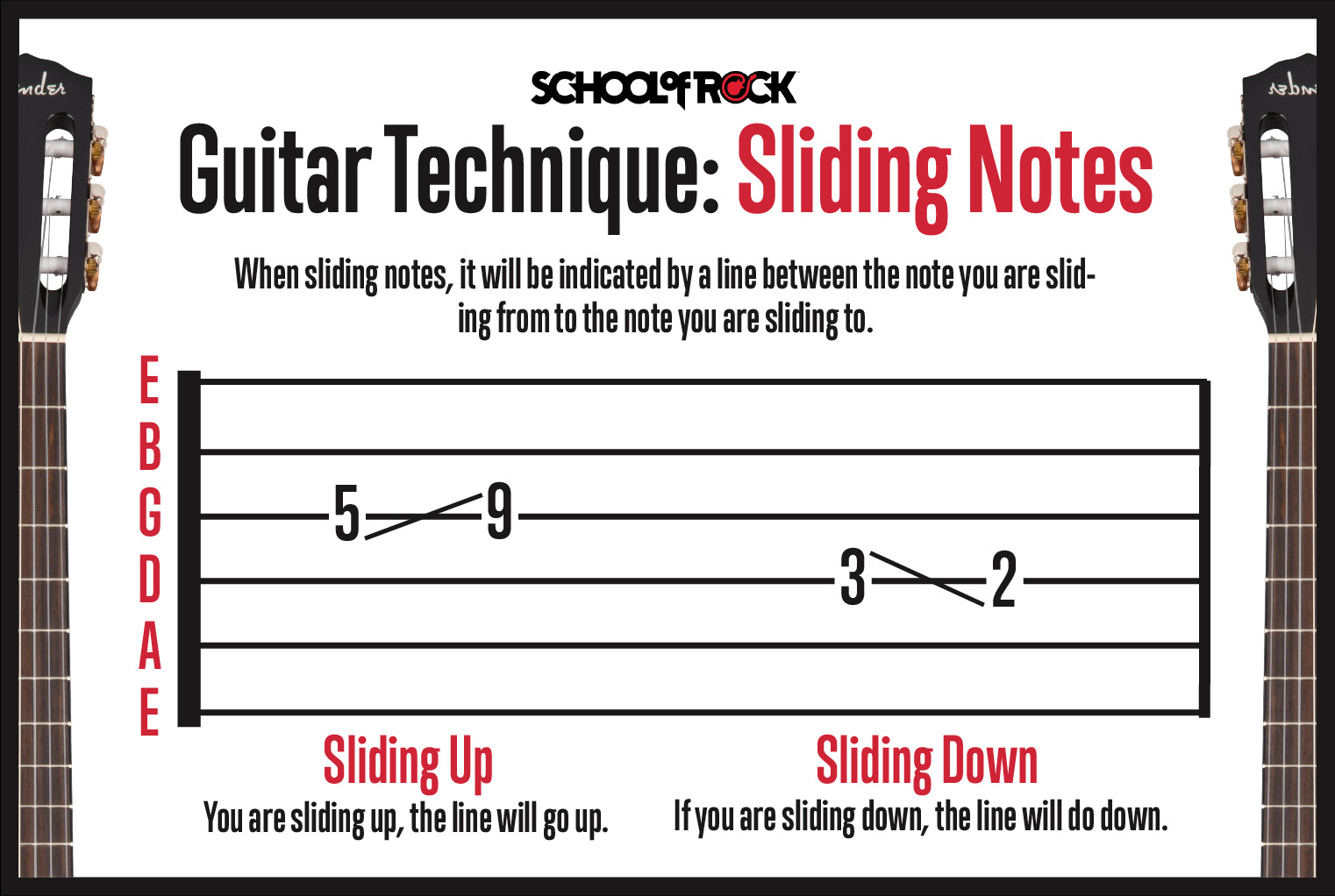 Guitar technique sliding notes
Guitar technique sliding notes
SLIDE DOWN: DESCENDING WITH EASE
Conversely, a slide down is also represented by a line connecting the starting and ending notes. If the target note is lower in pitch, the line might slant slightly downwards in the tab notation. The direction of the slant, though subtle, can be a visual cue for the direction of the slide.
HAMMER-ONS: LEGATO ASCENSION
The hammer-on is a legato guitar technique where you create a note without picking it directly. Instead, you “hammer-on” to the string with your fretting finger, forcefully striking the string onto the fretboard. You can hammer-on from an open string or from a previously fretted note. The resulting note will always be higher in pitch than the originating note. Hammer-ons are notated in guitar tabs with the letter “H” and an arc connecting either an open string to the hammered-on note or a fretted note to the subsequent hammer-on note.
PERFORMING HAMMER-ONS EFFECTIVELY
To execute a hammer-on, strike the string with your fretting finger with sufficient force to produce a clear, ringing note. This technique requires practice to develop the necessary finger strength and accuracy. Hammer-ons are generally easier to perform on electric guitars, especially with some volume amplification. A good starting exercise is to play an open low E string and then hammer-on to the third fret with your index finger, allowing the hammered-on note to sustain. Repeat this exercise on different strings and fret combinations to build your hammer-on technique.
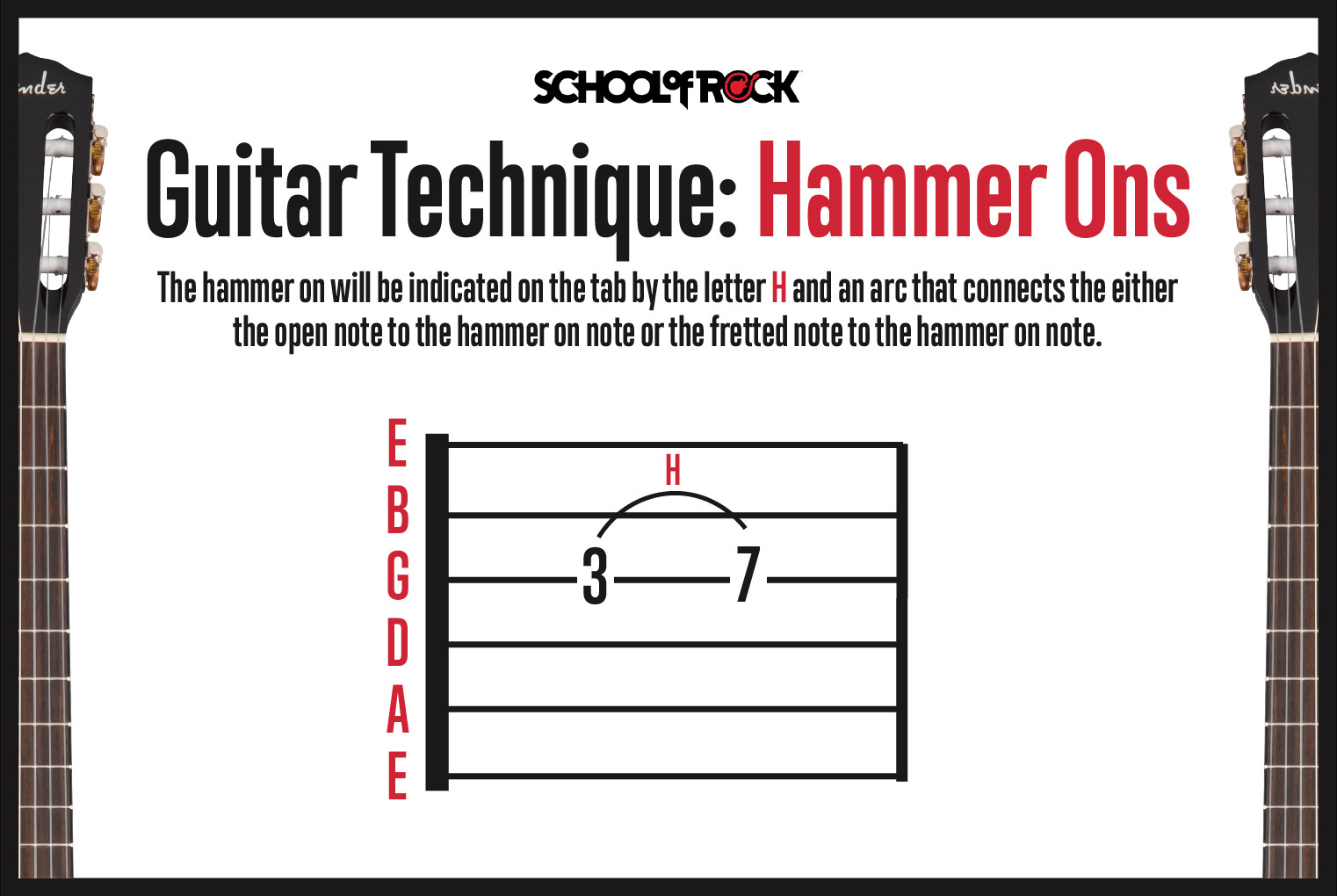 Guitar technique hammer ons
Guitar technique hammer ons
PULL-OFFS: LEGATO DESCENT
Pull-offs are the inverse of hammer-ons, another essential legato technique. Instead of hammering onto a string, you “pull-off” a fretted note, plucking the string with your fretting finger as you remove it from the fretboard. This action causes the string to vibrate and sound either an open string or a lower fretted note (if another finger is already fretting a lower note on the same string). Pull-offs are represented in guitar tabs with the letter “P” and an arc connecting the pulled-off note to the resulting open or lower fretted note. The resulting note will always be lower in pitch than the initiating note.
MASTERING PULL-OFFS
To perform a pull-off, you must already be fretting a note. Then, using a downward or sideways motion, you pull your fretting finger off the string, effectively plucking it. When executing pull-offs, aim to “grab” enough of the string with your fingertip as you pull off to ensure a clear and audible note.
Hammer-ons and pull-offs are often combined in sequence to create fluid, legato passages. By alternating hammer-ons and pull-offs in rapid succession, you can create a “trill,” a rapid alternation between two notes.
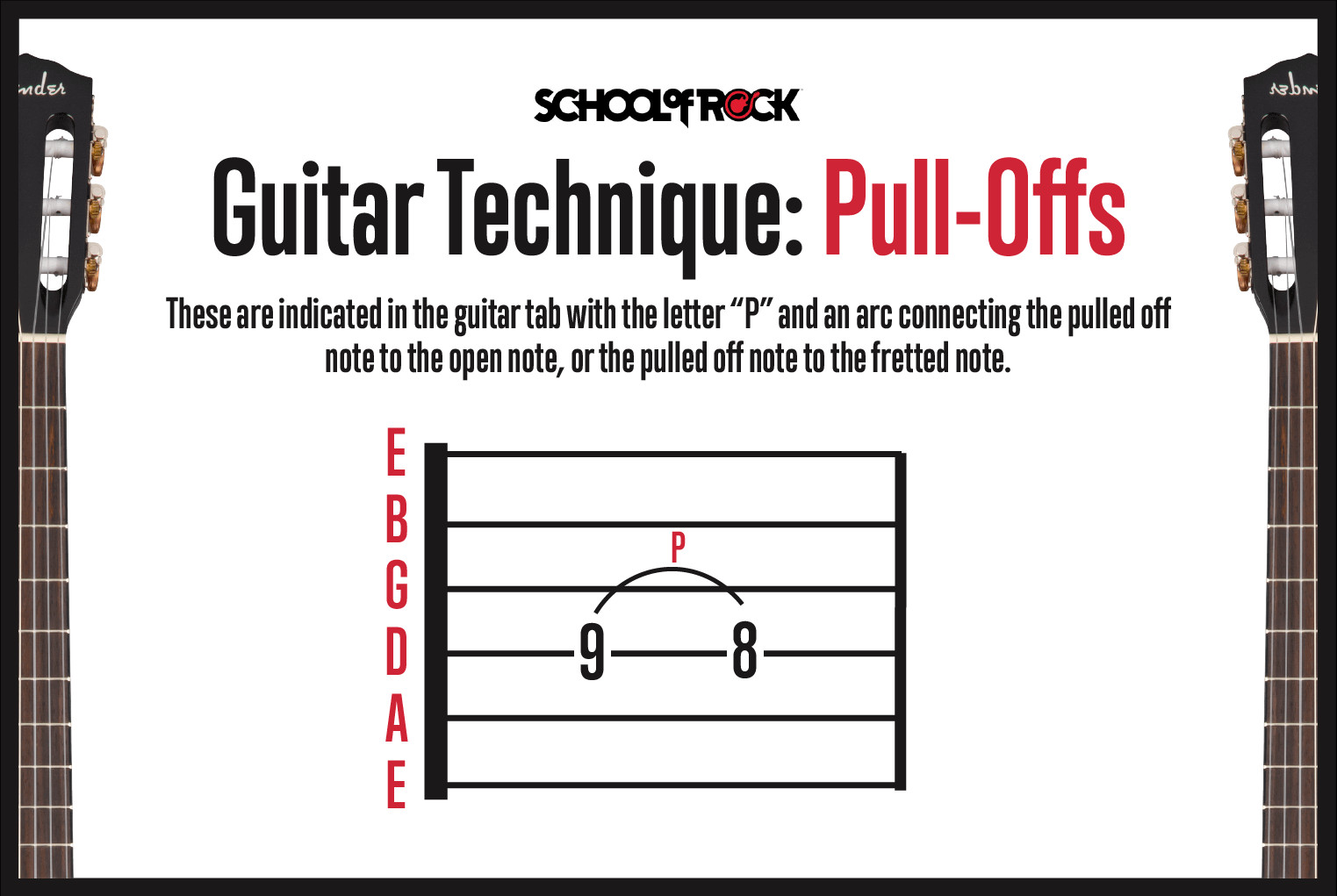 Guitar technique pull offs
Guitar technique pull offs
VIBRATO: ADDING EXPRESSIVE SHIMMER
Vibrato is a technique that adds warmth, emotion, and sustain to notes. It involves subtly and repeatedly bending a note and releasing it back to its original pitch without lifting your finger from the fretboard. This creates a pulsating, wavering effect on the note’s pitch and tone. Vibrato is indicated in guitar tabs by a zig-zag line drawn above the tab staff over the note where vibrato is to be applied. The length of the zig-zag line often visually suggests the duration of the vibrato. Generally, a longer zig-zag line implies a longer, more sustained vibrato.
DEVELOPING YOUR VIBRATO TECHNIQUE
Vibrato is similar to bending, but the pitch variation is much smaller and more rapid. You can apply vibrato using a single finger or by using a main finger supported by other fingers for added strength and control. Start practicing with a slow, smooth vibrato and gradually experiment with varying the speed and intensity to achieve different expressive effects. Like bending, vibrato is a highly personal technique, and each guitarist develops a unique vibrato style. It’s often described as being as individual as a fingerprint, contributing significantly to a guitarist’s signature sound.
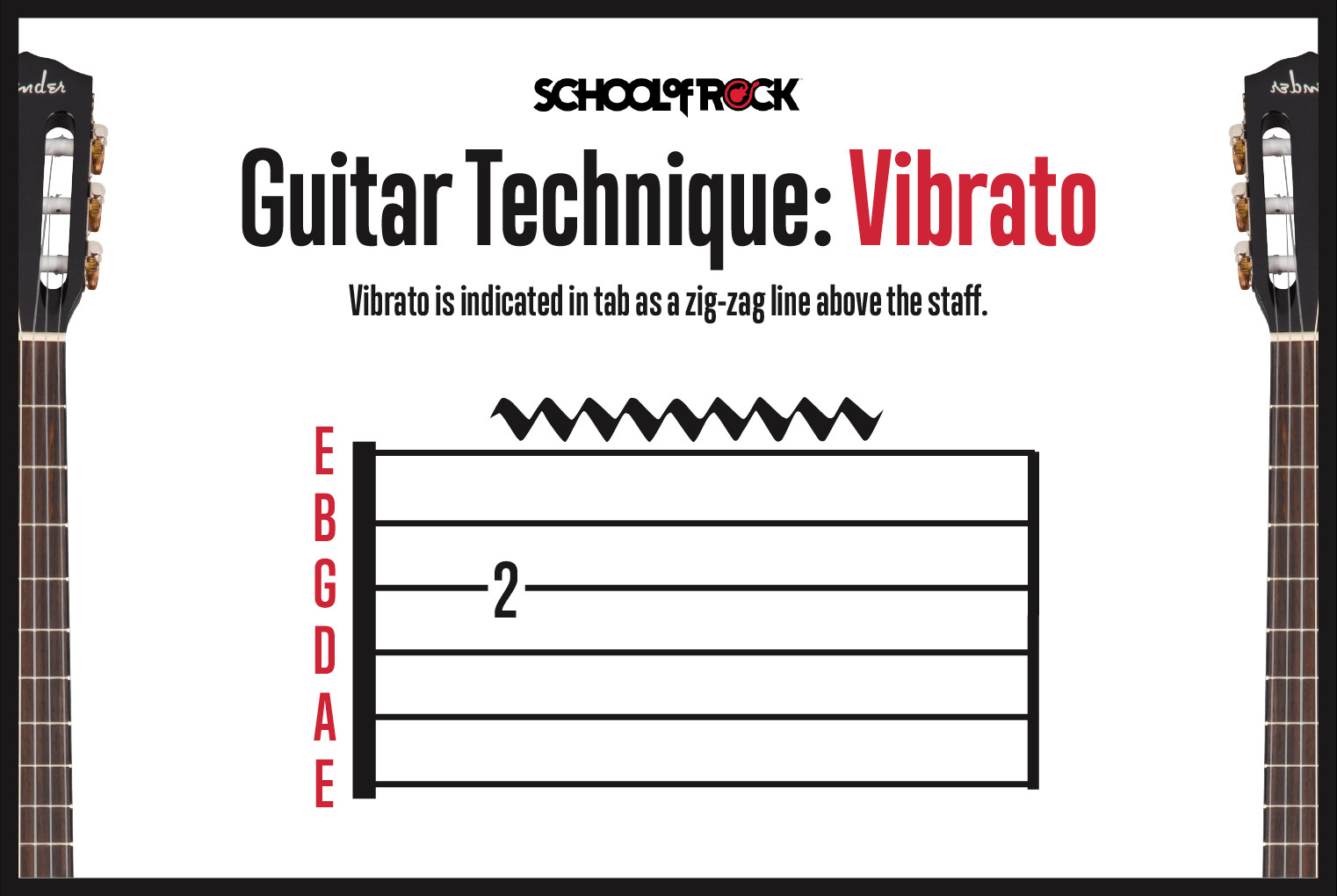 Guitar technique vibrato
Guitar technique vibrato
TAPPING GUITAR: TWO-HANDED FRETTING
Tapping is a more advanced technique that expands the guitar’s sonic possibilities by using both hands on the fretboard to create notes. It involves fretting notes with your regular fretting hand while simultaneously “tapping” or fretting notes with a finger from your picking hand, typically the index finger. The picking hand tap is essentially a variation of a hammer-on technique. Tapping is notated in guitar tabs by the letter “T” placed above the tapped note.
MASTERING TWO-HANDED TAPPING
Tapping was popularized by guitar virtuoso Eddie Van Halen, but the technique has roots in classical guitar. To perform tapping, fret a note with your fretting hand as usual, then use the index finger of your picking hand to forcefully tap a higher fret on the same string. This tapping action creates another note.
Tapping is akin to a hammer-on, but instead of using a finger from your fretting hand, you use a finger from your picking hand. This allows you to play notes with wider intervals than are reachable with just your fretting hand, significantly expanding your melodic and harmonic range. Playing with distortion and higher volume often makes tapping easier and more sonically impactful. Tapping also allows for incredibly fast playing, as you are effectively using both hands to fret notes.
 Guitar technique tapping notes
Guitar technique tapping notes
TWO-HANDED TAPPING: INDEPENDENT LINES
Two-handed tapping takes the technique further, involving both hands independently fretting notes without traditional picking. Both the fretting hand and the picking hand become active fretting hands, hammering-on notes independently. This technique is sometimes used to play bass lines with the fretting hand while simultaneously tapping melody or solo lines with the picking hand, creating complex and layered textures.
STRUMMING GUITAR NOTES: RHYTHMIC FOUNDATION
Strumming is fundamental to playing chords and creating rhythmic accompaniment on the guitar. When strumming chords, two primary strumming strokes are used: downstrokes and upstrokes.
Downstrokes are performed by moving your pick or strumming hand downwards across the strings, typically starting from the lower (bass) strings and ending on the higher (treble) strings. In guitar tabs, downstrokes are represented by a symbol resembling a thick horizontal line with two short “legs” pointing downwards on either side.
Upstrokes are the opposite, performed by moving your pick or strumming hand upwards across the strings, starting from the higher strings and ending on the lower strings. In guitar tablature, upstrokes are notated by a “V” shaped symbol.
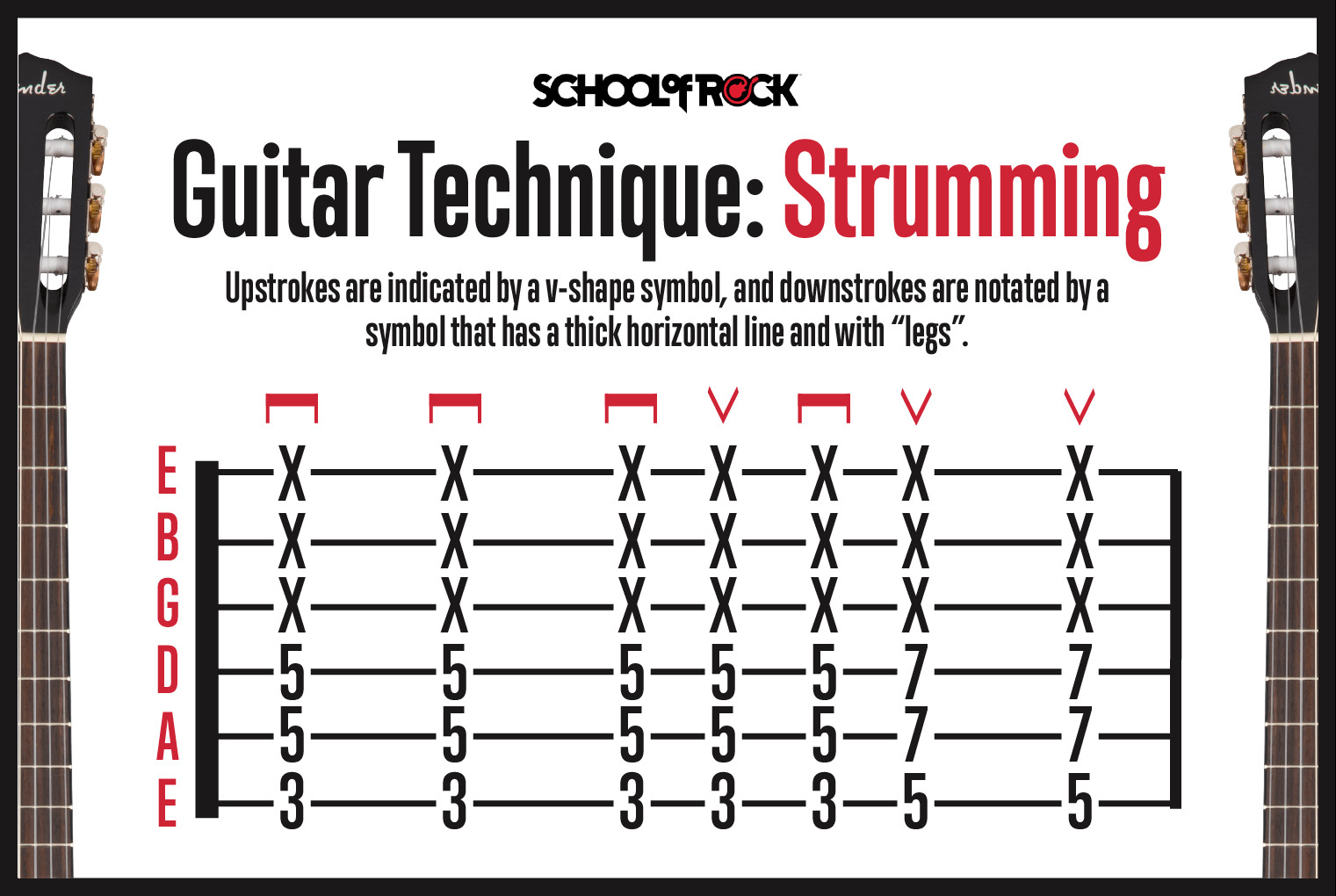 Guitar technique strumming
Guitar technique strumming
DEVELOPING STRUMMING PATTERNS
When playing chords, strumming patterns are dictated by the rhythm of the song. You can strum with a consistent downstroke and upstroke pattern or create more complex rhythms by varying the sequence of downstrokes and upstrokes. Songs with an eighth-note rhythm are often counted as “one and two and three and four and…” Many songs utilize alternating upstrokes and downstrokes in an eighth-note rhythm, with downstrokes typically falling on the numbered beats (1, 2, 3, 4) and upstrokes on the “ands.”
STRUMMING SINGLE NOTES: DYNAMIC ARTICULATION
The same downstroke and upstroke notation applies even when playing single notes in guitar tabs. A downstroke symbol indicates that you should pick the note with a downward motion of your pick. Conversely, an upstroke symbol above a single note indicates that you should pick the note with an upward motion of your pick. These strumming directions, even for single notes, can affect the attack and articulation of the note, adding subtle rhythmic nuances to your playing.
READY TO EXPLORE MORE GUITAR TECHNIQUES?
Congratulations! You’ve now gained a solid understanding of how to read guitar tabs and learned about a range of essential guitar techniques. You’re equipped to start deciphering tabs and playing your favorite music. From basic strumming to advanced techniques like tapping, guitar tabs provide a visual and accessible pathway to musical expression on the guitar.
At guitarplayers.net, we are dedicated to helping guitarists of all levels reach their full potential. Explore our resources for beginner lessons to advanced technique guides. Our expert instructors have the knowledge and experience to guide you on your guitar journey, helping you quickly learn to play the rock songs you love and beyond.
Ready to find guitar tabs for songs you want to learn? From easy beginner songs to challenging pieces for experienced musicians, guitarplayers.net can point you in the right direction. Explore online tab resources and sheet music providers to build your repertoire and continue your musical exploration.
[Placeholder for internal link to guitar buying guide]
Thinking about getting a new guitar? Check out our comprehensive Guitar Buying Guide for helpful tips and advice!
